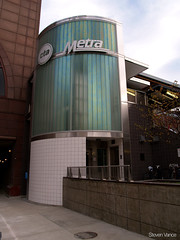
The transit task force Governor Pat Quinn convened last year after the Metra governance scandal continues to discuss the merits of a single transit authority to replace the Regional Transportation Authority and absorb Chicago Transit Authority, Metra, and Pace. Count Mayor Rahm Emanuel and CTA President Forrest Claypool among the opponents of that idea.
Emanuel and Claypool came out strongly against the proposal because they believe the CTA would become less accountable to Chicagoans. Emanuel spokesperson Sarah Hamilton told the Sun-Times:
Chicagoans demand a public transportation framework that is accountable to riders and taxpayers, which is what we have at the CTA. The mayor is not interested in a solution that replaces one unaccountable bureaucracy with another.
Hamilton's right that Chicagoans – and residents of the 35 other municipalities the CTA serves – deserve accountable transit agencies. And under Emanuel, the CTA has had a lot of wins, including new stations, new buses, and a successful Red Line South revamp.
But the CTA isn't the only organization that's part of the discussion. Pace and Metra -- and all the riders who depend on their services -- also need to be considered. These riders don't care who is providing the bus from home to work, whether it's Pace or CTA, or whether the Chicago mayor is calling the shots or not.
What matters is the rider. Would a regional transit agency serve the region's transit riders better than the status quo? It certainly could help address some of the problems that are plaguing Chicagoland transit.
Right now, the region's transit agencies basically compete for riders. Different agencies run similar routes that serve the same trips, and all three agencies have their own marketing departments, appealing to the same pool of potential customers. The agencies don't make much effort to integrate fares, other than some extremely limited inter-agency transfers.
And instead of making a collective case to the state legislature for funding, each service board is, in effect, represented separately by various state legislators whose constituencies are easily divided along "agency lines." A unified agency could be structured to allocate funding by performance instead of by geography: The task force recommends that any distribution of funds by formula incorporate performance measures.
Ventra and fare integration is another area where regional coordination could help. The state legislature mandated a universal fare system by 2015, but CTA started down the Ventra path alone, without the RTA's involvement. Pace later jumped on board, but Metra only plans to use Ventra as a medium to purchase tickets and not act as the ticket itself. Metra also plans to launch a service that allows riders to show a ticket on their smartphones.
It makes sense that City Hall doesn't want to cede authority to the state, especially given the state's abysmal recent record on transportation issues. But Stephen Schlickman, director of the University of Illinois at Chicago’s Urban Transportation Center and the previous RTA executive director, told the Sun-Times that Chicago's interests could still be represented in a single agency, if it's structured right:
Chicago's mayor might lose control of the CTA under it, he wrote in an Oct. 8 letter to the task force [PDF], but an RTA-like requirement of "supermajority" votes could allow Chicago members appointed by the mayor to protect Chicago's interests.
Right now, Schlickman said, "We have 47 board members, four boards, and everyone is pointing fingers at each other as to who is accountable.'"
Opposing a regional transit agency may be a smart opening position for the upcoming debate in the state legislature over the structure of Chicago transit governance, but City Hall should be flexible. Hopefully Emanuel is open to the benefits that a smartly-structured unified transit agency can bring to riders.




